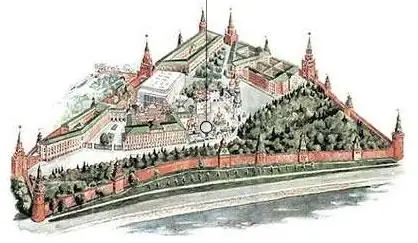- Author Harold Hamphrey [email protected].
- Public 2023-12-17 10:06.
- Last modified 2025-01-24 11:10.
The Pisa Cathedral is located in the small Italian town of Pisa. The cathedral, together with the famous Leaning Tower of Pisa and the Baptistery, is the hallmark of the city, attracting hundreds of thousands of tourists every year. The city was founded more than two thousand years ago, today a little less than 90 thousand people live in it. The famous Galileo Galilei was born here and taught at the local university, and the botanical garden in the city rightfully claims to be the best in the world. The temple completes the magnificent medieval look of an amazing city, any resident will be happy to tell and show where the Pisa Cathedral is located.
The history of the construction of the temple
The Pisa Cathedral is the cathedral of the city and one of the oldest in Italy. It was founded in 1063, during the prosperity of Pisa, which became one of the largest trading hubs in Italy. The construction lasted for about two centuries, during which time the cathedral acquired its unique and inimitable appearance.
It was designed by the architect Buscheto di Giovanni Giudice, who in those days was known for unconventional thinking and scope in construction. Before him stood a complexthe task was to build a building that would overshadow the beauty and design of St. Mark's Cathedral in Venice, which was being built at the same time. Pisa and Venice competed with each other in everything, and the Pisan authorities could not lose this dispute.

Busqueto conceived a completely grandiose cathedral - in one building he wanted to embody several areas of architecture at once. So the Pisa Cathedral, the style of which became revolutionary for those times, received Byzantine, Lombard and Muslim elements. Busqueto managed not only to build an incredibly beautiful church, he created a fundamentally new direction in architecture - the Pisan Romanesque style.
Appearance
The design of the main facade of the cathedral was done by another architect, Rainaldo. He supplemented Busqueto's ideas with his own, erecting several more similar structural elements. The main facade received a new look - now it was decorated with semicircular arcades, made in a light manner. It was lined with black, white and blue marble in a checkerboard pattern. This simple solution looks very impressive, contrasts under the bright sun and attracts admiring glances.

The arches and columns of the cathedral were made by the best craftsmen of the time, which can be seen in the care of every detail. The Pisa Cathedral has the shape of a cross, when viewed from above - this is a traditional solution for Catholic cathedrals. Its appearance amazes tourists with the splendor of granite vaults, a huge number ofsculptures and the smallest details, made with jewelry precision.
Interior decoration
To this day, the original interior appearance of the Pisa Cathedral has not been preserved. Italy at the end of the 16th century experienced powerful fires, one of them also occurred here, destroying wooden structures. After this tragedy, all the walls were decorated with black and white marble, and the ceiling was gilded with the Medici coat of arms.

After the fire, a mosaic of 1302, which depicts Christ, and the pulpit created at the same time, which today has become a unique exhibit of medieval sculpture, survived. Its upper part depicts the main scenes of the New Testament, which were carved in marble.
Leaning Tower of Pisa
The tower was laid shortly after the main construction of the cathedral was completed. The first stones in the foundation of the structure were laid at the end of the 12th century, the construction of its walls lasted almost a hundred years under the guidance of different architects and was interrupted several times due to the resulting slope.
In the 13th century, it was decided to correct the slope with the help of specially erected uneven balconies, but this did not lead to success, the slope continued. The construction ended in 1350, in total 8 floors were built with a total height of 56 meters.

The slope of the tower is due to the soft ground at its base. The mistake made during the design made the city famous all over the world, and the name of the tower became a household name. Eacha tourist who has visited Italy seeks to take a photo with this attraction. In 2008, scientists said that the process of falling has almost stopped.
Baptistery
The Pisa Cathedral includes in its ensemble another building that strikes with its unique style - the Baptistery. It is the largest in Italy, its circumference exceeds 100 meters. Like the tower, it combines two styles, Romanesque and Gothic, as it was built at different times by different architects.

The building is entirely made of marble. The first tier is decorated with arches built in the Byzantine style, then gothic prevails - smaller arches, denticles, twin structures. The interior of the cathedral is distinguished by restraint. The building is decorated with pyramidal and round domes, which creates a unique acoustics inside.
What else to see in Pisa
Of course, tourists head to Pisa to see these masterpieces of medieval architecture and enjoy the unique view of the Leaning Tower of Pisa. But when you arrive in Pisa, you should pay attention to the city itself.
Not far from the complex is the Campo Santo cemetery. It is made in the same style as the Pisa Cathedral, photos with Gothic arches and Romanesque vaults in excursion guides are on a par with the tower itself. Pisan cuisine differs from traditional Italian cuisine in its spicy taste and sharpness of execution: numerous restaurants and cafes treat tourists to classic dishes that Galileo Galilei tried here.






